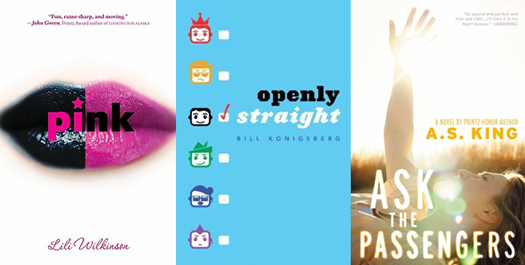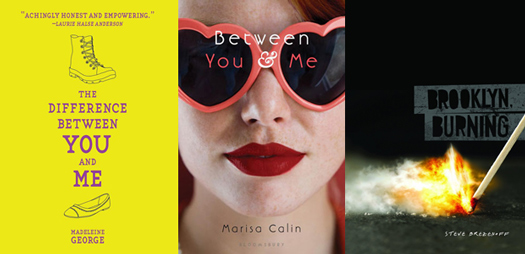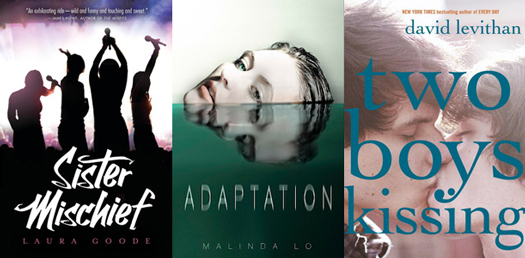Coming Out 2.0
 Traditionally, the young adult coming-out narrative goes sort of like this: Teen realizes he/she might be gay, then is freaked out by this realization. Teen works through his/her internalized homophobia, and if he/she’s lucky, he/she finds a same-sex love interest. They have a romance, though it may be secretive, and at some point, their relationship or the Teen’s homosexuality is shockingly revealed. Negative consequences may follow, although typically some sort of acceptance is also delivered.
While there’s nothing inherently wrong with this kind of story — and in fact, many LGBT people go through very similar experiences in real life — it can have the result of problematizing homosexuality as an issue to be dealt with. Some contemporary YA novels with LGBTQ main characters still follow this same general format, but recently other books have given the coming-out narrative interesting new twists — what I’m calling Coming Out 2.0.
Traditionally, the young adult coming-out narrative goes sort of like this: Teen realizes he/she might be gay, then is freaked out by this realization. Teen works through his/her internalized homophobia, and if he/she’s lucky, he/she finds a same-sex love interest. They have a romance, though it may be secretive, and at some point, their relationship or the Teen’s homosexuality is shockingly revealed. Negative consequences may follow, although typically some sort of acceptance is also delivered.
While there’s nothing inherently wrong with this kind of story — and in fact, many LGBT people go through very similar experiences in real life — it can have the result of problematizing homosexuality as an issue to be dealt with. Some contemporary YA novels with LGBTQ main characters still follow this same general format, but recently other books have given the coming-out narrative interesting new twists — what I’m calling Coming Out 2.0.
A few recent books question the concept of sexual orientation labels entirely. These books include Pink by Lili Wilkinson and Openly Straight by Bill Konigsberg, two novels in which teens who have already come out as gay switch the tables by trying out heterosexuality. Ask the Passengers by A.S. King involves a girl who is in a relationship with another girl, but who also consciously questions the need to label herself as gay. Notably, her questioning of labels isn’t about repressing her sexuality; it’s about not wanting to limit things.

The Difference Between You and Me by Madeleine George and the similarly titled but quite different novel Between You and Me by Marisa Calin are contemporary stories about queer girls that avoid labels and sexual orientation-related identity crises, but do not avoid queer identity or love. Brooklyn, Burning by Steve Brezeneff never identifies the narrator’s gender, thus asking the reader to decide whether the love story is gay or straight — or whether sexual orientation even matters.

These new narratives about queer teen identity also include new versions of parenting. In Laura Goode’s Sister Mischief, the main character comes out to her father in the Prologue — before the story even truly starts — and her dad responds, “Cool with me, kiddo.”
In my novel Adaptation, I knew I wanted to avoid a traditional coming-out narrative even though the main character, Reese, has to come to terms with her attraction to a girl. I purposely wrote a scene in which she and her girlfriend are discovered together by her mother — a disastrous moment in a traditional coming-out novel — but in Adaptation, Reese’s mom teases her by saying, “She’s cute.”
In David Levithan’s Two Boys Kissing, parents have a variety of reactions, ranging from parents who eagerly support their son’s effort to set a world record in same-sex kissing, to parents whose worldviews are still challenged by their child’s sexual orientation.

Two Boys Kissing may be one of the best examples of how coming-out narratives have changed within YA, because the novel also addresses the way things used to be. Via the unnamed narrators, who are the ghosts of departed gay men, Two Boys Kissing gives a sense of perspective to the lives of the contemporary gay teen boys, and shows that even though pockets of homophobia still exist in some situations, we’ve truly come a very long way. Coming out in 2013 is an entirely different experience — and often a more positive one — than coming out only twenty years ago in 1993. I think that’s exactly as it should be.
>>>
Want to win some amazing LGBTQ YA novels, including Adaptation, Two Boys Kissing, Pink, and Openly Straight? Enter the Giant YA Pride 2013 Giveaway!